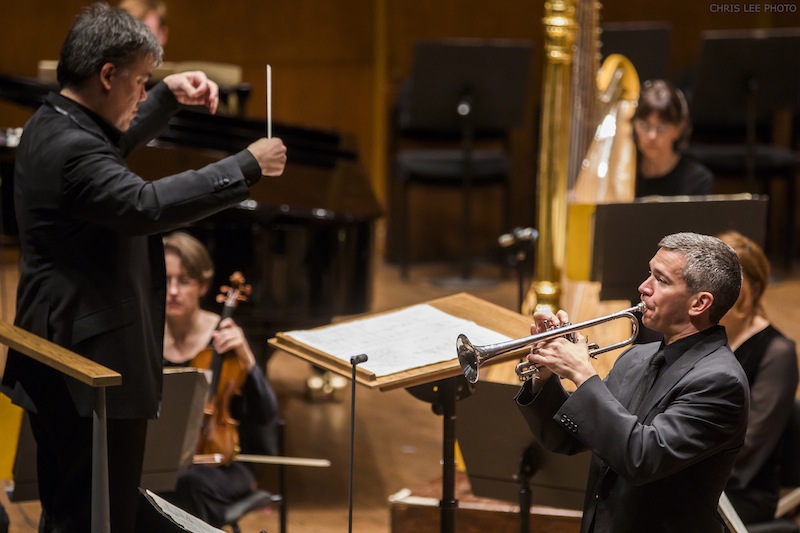The best of times and the worst with Philharmonic’s tale of two soloists

Alan Gilbert conducts the New York Philharmonic in Ligeti’s “Mysteries of the Macabre” with principal trumpet Christopher Martin Thursday night at David Geffen Hall. Photo: Chris Lee
An odd meeting of musicians and composers took the stage in David Geffen Hall Thursday night, with Alan Gilbert and the New York Philharmonic supporting two soloists in well-known works–one an international keyboard superstar, the other the Philharmonic’s new principal trumpet in his solo debut.
The concert opened with a feature for the latter, Christopher Martin. Instead of a conventional concerto, the piece was Ligeti’s Mysteries of the Macabre, his irreverent dismantling of the concerto idea adapted from this equally irreverent opera, Le Grande Macabre.
An intriguing and winning choice—the soloist doesn’t just play the trumpet but has to really perform. This started with the theatrical entrance, Martin rushing in from offstage in the nick of time, satisfying the puzzlement of conductor Alan Gilbert, who himself had wandered out on stage in an apparent state of confusion. Martin—and Gilbert and much of the orchestra—had to whisper, speak, make funny sounds, and do it all in time and with confidence.
The trumpeter was a natural, and a fine instrumentalist as well. Mysteries is a compact piece, but it does stretch the instrument into the upper register and across a range of dynamics. Martin played with a full, amber-tinged sound and smoothly varied his articulation from hard and bright to pillowy and mellow. Best of all was the sense of humor presented by Martin and all the musicians.
The concerto for Lang Lang was Beethoven’s Fourth Piano Concerto, and what a mismatch this proved. Things were promising for the early minutes, with Lang Lang’s modest playing of the opening chords appropriate for the great weight of dignity in the music.
But the comity didn’t last and tragicomedy soon ensued. In the body of the opening movement, the soloist went glibly from one phrase to the next, doing nothing to connect each to the other or to the larger whole. Beethoven is the great architect of music, and Lang dashed through the rooms of the concerto like an interior decorator with ADHD.
The piano part has plenty of technical challenges, but this is Beethoven, so there’s a complex human expression inside. Lang did not seem to notice any of it, weirdly trying to wring poetry out of his regard for his own hands in the flurry of 16th notes, and playing sparser or more sustained passages with impatience.
There is tremendous poetry in the second movement, but Lang Lang put the emphasis on his own pianism, and music that should be enthralling came off as dull.
The soloist is widely regarded as having great technique, if questionable musicality, but that is not really true. Technique is a means with which to make the music speak, and Lang Lang occluded Beethoven—runs came out as smears, there was too much pedal in all the wrong places. He failed to properly articulate Beethoven’s syncopations and changing pulse. Lang Lang doesn’t have technique–he merely has dexterity, and there’s nothing particularly musical about that.
Gilbert and the orchestra responded with restraint and the feeling that for their part they would make the case for Beethoven. This was welcome relief as the piece went on but made for a bizarre Rondo, not so much call-and-response as some sort of phone tag.
Of the many pianist’s fans who came to the hall to hear Lang, the good bulk of them stuck around for the second half performance of Bartók’s Music for Strings, Percussion, and Celesta. Gilbert and the orchestra took a skillful, objective approach to this great score, less atmospheric than many famous Bartok interpreters of the past, but more steely in small and large-scale architecture.
There was a danger that this would fall flat at the start, as the concentration on the fugue, especially the placement of each phrase in the constantly changing time signature, limited the evocative expression that is inherent in Bartók’s music. But from the first forte on, the orchestra produced substantial energy.
They also played the second movement with an exceptional rhythmic feel, the piano/percussion/pizzicato hits swinging in a way that is rarely achieved in this music, but that is appropriate and brilliant. The strange, poker-faced night music was successful, revealing the technique of the music in a way that pushed the composer’s unusual aesthetic the fore.
The final movement proved the highlight. The emphasis on form came through in the dance-like transformation of the work’s opening material. Bartók confounds conventional expectations of light and dark, instead working on a complex and subtle spectrum of chiaroscuro. The recollection of the earlier music, and the biting conclusion were an honest and informed response to the composer’s challenges.
The program will be repeated 8 p.m. Friday and Saturday. nyphil.org







Posted Oct 10, 2016 at 9:37 am by Frank
Thank you for returning my sanity. I thought I was the one who had gone mad. I noticed during the performance of the Beethoven that half the audience around me had quite literally fallen asleep! A few minutes later they were all on their feet applauding wildly. By the way – the selfsame audience remained fully awake during the much less familiar Bartok!